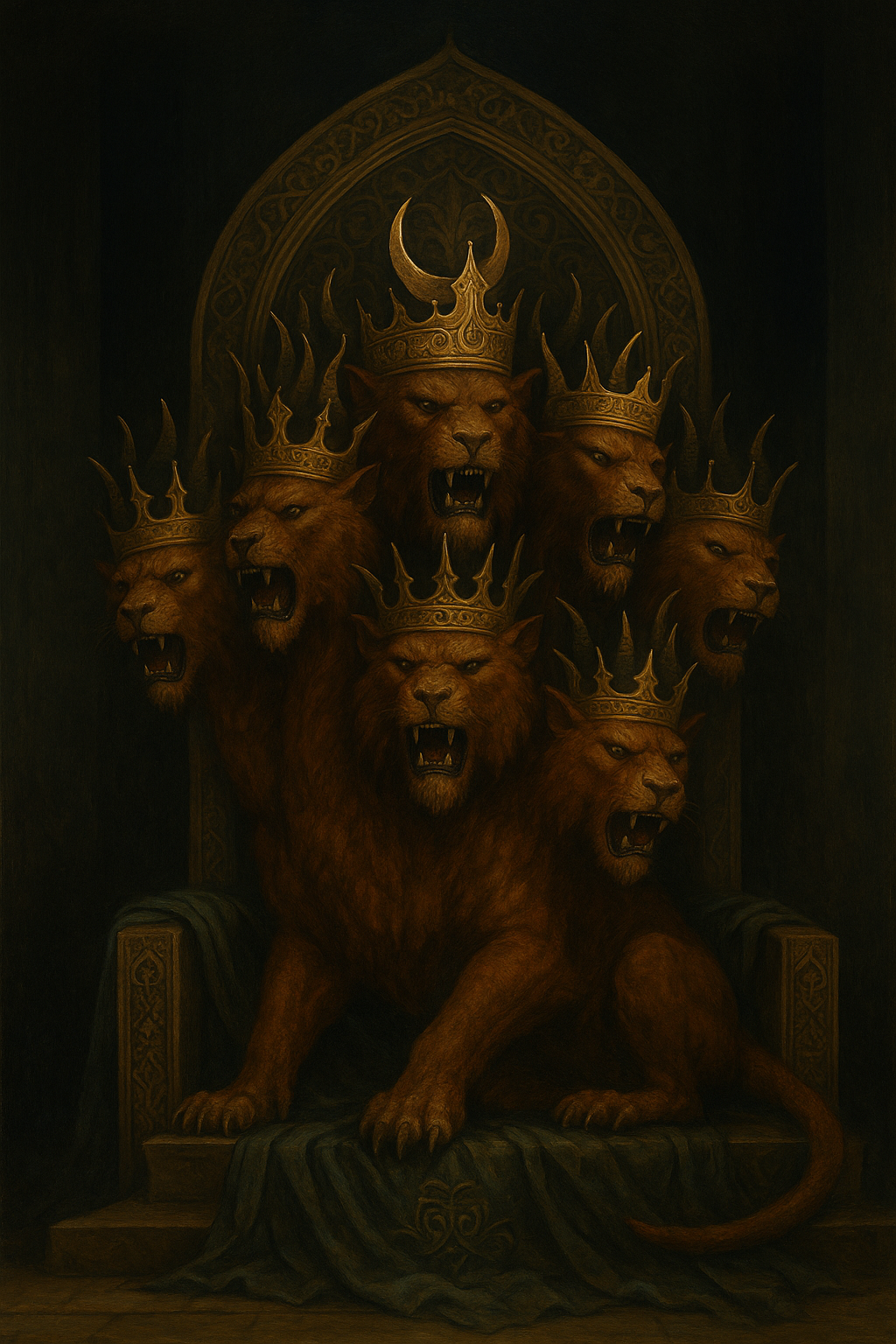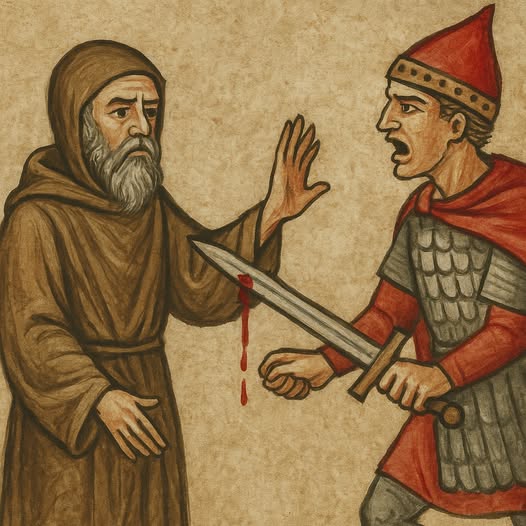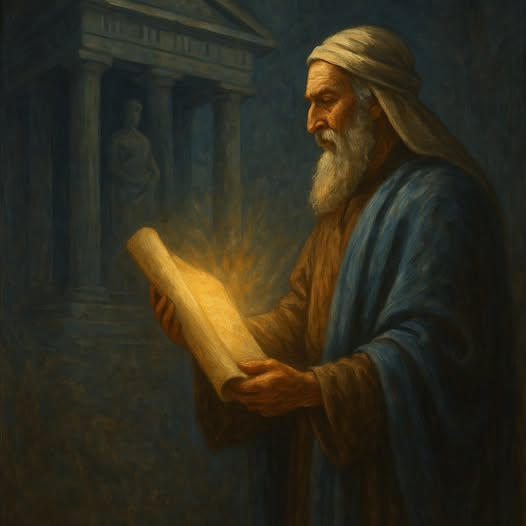
The Islamic Antichrist theory proposes a significant shift from traditional Christian eschatological perspectives, suggesting that the Antichrist will arise from an Islamic context rather than a revived Roman Empire. Rooted in interpretation of biblical prophecy alone, this theory examines how a later, non-biblical system, Islam, may fulfill the role of a counterfeit, opposing God’s redemptive plan revealed through Scripture.
The Foundation of the Theory
Proponents of the Islamic Antichrist theory identify numerous inverted parallels between the biblical Antichrist and figures found in Islamic eschatology, specifically the Mahdi and Isa (the Islamic Jesus). These parallels are not drawn because Islamic “prophecies” are valid, but because they represent a blasphemous parody of biblical end-time truths.
Islam arose over 600 years after the close of the biblical canon, meaning its eschatological claims are not original but reactive. It borrows from, distorts, and weaponizes key biblical themes, not as divine revelation, but as a deliberate theological opposition to the Gospel.
A Deuteronomy 32 Worldview: Why Islam Arose When It Did
According to the biblical worldview revealed in Deuteronomy 32:8–9, the nations were divided among the sons of God after Babel, and Yahweh chose Israel as His own inheritance. These divine beings, tasked with stewarding the nations, rebelled and led their peoples into darkness. By the time of Christ, their influence permeated the pagan world. But when Christ rose from the dead and ascended to the right hand of the Father, He stripped these rebel gods of their authority and reclaimed dominion over the nations (Matthew 28:18; Colossians 2:15). Their rule was broken, but their defiance remained.
Islam’s emergence must be seen in this context, not as a parallel tradition, but as a calculated spiritual counteroffensive. It did not arise during the height of paganism or the early persecution of the Church. It arose after Christ’s victory and after Christianity had begun to saturate the known world. And it spread like wildfire through the very regions that had once embraced the Gospel: North Africa, the Levant, Mesopotamia, Arabia, Persia, and Asia Minor. Islam’s trajectory reads like a map of Christian strongholds that were overturned.
This is not accidental. Islam functions as a vessel for the dispossessed gods of the nations to reassert control. It offers a new, theologically aggressive system aimed at wiping out Judaism and Christianity, replacing the worship of Yahweh with submission to Allah, and recasting Jesus as a subordinate figure under a counterfeit messiah. Islam is not just another false religion; it is a coordinated response from the powers that were stripped of their dominion, working to deceive, conquer, and destroy everything Christ reclaimed.
A Foreign God Unknown to the Fathers
The prophet Daniel foresaw that the final enemy of God would not honor the gods of his fathers, nor the desire of women, but would instead honor a foreign god, a god unknown to his ancestors (Daniel 11:37–39). Islam fits this description exactly. It emerged long after the biblical period, offering a new name for God, a new book, a new prophet, and a new law. It did not develop from the line of Abrahamic covenant but stood outside of it, redefining the past and laying claim to the future. The Antichrist’s devotion to a god foreign to the biblical fathers reflects the nature of Islam itself, a religion not derived from the worship of Yahweh, but designed to replace Him. In this light, Islam is not a corrupted continuation but a total replacement, and the Antichrist’s allegiance to such a system marks him not just as a deceiver, but as a direct enemy of the covenant God of Israel.
Islamic Eschatology: A Counterfeit Narrative
Islamic eschatology is not inspired by God and carries no prophetic authority. It emerged long after biblical prophecy had been completed. It does not reveal divine truth, but instead mimics and inverts it. The figures it exalts, particularly the Mahdi and Isa, mirror the roles of Christ and His prophets, but in ways that subvert and distort the Gospel. Rather than offering a true vision of the end, Islamic eschatology functions as a counterfeit system designed to deceive the nations and oppose the reign of Christ.
The Mahdi
In Islamic eschatology, the Mahdi is not portrayed as a mere political figure but as the divinely appointed agent of Allah, whose rule all Muslims are commanded to obey. He is expected to appear near the end of days to lead the global Islamic community, reestablish the Caliphate, and enforce Islamic law over the entire earth. Islamic texts describe his authority as absolute, and obedience to him is equated with obedience to Allah. He is not simply inspired; his judgments are to be followed without question.
He is believed to be infallible, divinely protected from error, and will return to rule with perfect justice. His commands will be treated as divine directives, and his leadership will be the instrument of Allah’s final judgment on Earth.
Islamic traditions teach that the Mahdi will lead military campaigns to conquer non-Muslim lands and subject all people to Islamic governance. He will rule from Jerusalem, destroy all religious systems opposed to Islam, and establish global submission to Allah. Though Islam claims to uphold monotheism, the Mahdi receives a level of devotion, obedience, and allegiance that functionally constitutes worship. The reverence for him goes far beyond political loyalty; it replaces the messianic role of Christ with a counterfeit empowered by a false god. This portrayal matches the biblical description of the Antichrist, who exalts himself and demands the allegiance that belongs to God alone.
Isa (Islamic Jesus)
According to Islamic eschatology, Isa returns not as the divine Son of God, but as a prophet who denies His crucifixion, rebukes Christians, and submits to the Mahdi. He is said to break crosses, abolish the jizyah tax by eliminating other faiths, and lead campaigns to eliminate Christianity. Isa’s role is not to save, but to reinforce Islamic dominance. His subordinate status and denial of Christian doctrine place him firmly in the role of the False Prophet, performing signs and enforcing submission to a false messianic figure.
Al-Masih ad-Dajjal: The Islamic Counter-Antichrist
Islamic eschatology contains a curious figure called al-Masih ad-Dajjal, often translated as “the false messiah” or “deceiver messiah.” This being is said to come before the Day of Judgment, riding a fantastical beast—often described as a flying donkey with extraordinary features—and performing signs and wonders to deceive the masses. In Islam, Dajjal is portrayed as the great deceiver whom Isa (the Islamic Jesus) will return to kill.
At first glance, this seems to invert the biblical narrative, presenting the Islamic Jesus as the hero and this Dajjal as the villain. However, under the lens of the Islamic Antichrist theory, it becomes clear that this deception runs deeper. The Dajjal’s profile—performing signs, gathering a following, and claiming a special status—bears a striking resemblance to the true Jesus Christ of Scripture. In this scenario, Islam anticipates the return of the real Christ as its greatest enemy, portraying Him as the deceiver who must be stopped.
This inversion further underscores the role of Islamic eschatology as a blasphemous counterfeit. Not only does it anticipate a false messiah in the Mahdi, and a false prophet in Isa, but it also demonizes the return of the true King as the final threat to be overcome. This reveals the spiritual inversion at the heart of Islamic end-times teaching: a deliberate reconfiguration of biblical truth designed to oppose God’s plan at every turn.
Key Biblical References
Several passages in the Bible are cited by proponents of the Islamic Antichrist theory to demonstrate how biblical prophecy may be fulfilled through a system that mirrors Christ’s kingdom while opposing Him.
- Daniel 7:25 describes the Antichrist as one who will speak against the Most High and oppress His holy people. This mirrors Islamic expectations of the Mahdi, who is prophesied to lead a global jihad and enforce Islamic law, silencing opposition and suppressing Christianity. The oppression of the saints fits within the pattern of persecution historically and prophetically associated with Islamic conquest.
- Revelation 13:4 portrays the Beast as a global leader who inspires awe and receives worship. Within Islam, the Mahdi is expected to receive total allegiance from the Muslim world and establish global Islamic rule. This vision of a world leader demanding submission aligns disturbingly well with the Bible’s warnings of a final deceiver.
- In 2 Thessalonians 2:4, the man of lawlessness is said to exalt himself, setting himself up in God’s temple and proclaiming to be God. The Mahdi is expected to rule from Jerusalem, not merely as a political leader, but as the final authority on Earth through whom Allah’s will is executed. His leadership abolishes the worship of Christ and replaces it with a religious system that demands submission to a false god. His assumed authority over Jerusalem and his eradication of all competing faiths mirror the Antichrist’s prophesied defilement of God’s holy place.
- Revelation 13:11–12 introduces a second beast, often called the False Prophet, who supports the first beast and compels the world to worship him. In Islamic eschatology, Isa, the Islamic version of Jesus, returns to support the Mahdi’s leadership, deny the divinity and crucifixion of Christ, and lead Islamic armies in suppressing Christianity. His subordinate role and deceptive signs mirror the biblical profile of the False Prophet.
- Matthew 24:15 and Daniel 11:31 speak of the abomination of desolation standing in the holy place. Islamic traditions teach that the Mahdi will rule from Jerusalem and establish Islamic law as the global authority. For Christians, this act represents not a positive fulfillment, but a desecration of the Holy City, aligning with the blasphemous reign described in prophecy.
Supporting Islamic Texts
Though uninspired and theologically flawed, Islamic texts reveal the nature of this deception. Hadith literature presents the Mahdi and Isa in roles that mimic and oppose biblical figures.
- For example, Sahih Muslim 2937 describes Isa breaking the cross and killing pigs—actions that symbolically reject Christianity.
- Sunan Abu Dawud 4282 speaks of the Mahdi leading the Muslims and Jesus praying behind him, signifying Isa’s submission to Islamic leadership.
- In Sahih al-Bukhari 3448, the Mahdi’s conquests and the elimination of jizyah are foretold, implying the forced conversion or elimination of non-Muslims. Islamic scholars throughout history have expanded upon these expectations, codifying a system that denies the deity of Christ, nullifies the cross, and sanctifies global conquest in the name of Allah. and theologically flawed, Islamic texts reveal the nature of this deception.
Hadith literature presents the Mahdi and Isa in roles that mimic and oppose biblical figures. Islamic scholars throughout history have expanded upon these expectations, codifying a system that denies the deity of Christ, nullifies the cross, and sanctifies global conquest in the name of Allah.
The Fourth Empire in Biblical Prophecy
The Book of Daniel describes four empires, the last of which is “different from all the others” (Daniel 7:7), trampling the earth and waging war on the saints. While these empires have traditionally been identified as Babylon, Medo-Persia, Greece, and Rome, the fourth empire must meet specific criteria. It must rule the same territory as Nebuchadnezzar’s Babylon and possess a level of brutality and spiritual opposition that surpasses its predecessors.
Rome, though it engaged in persecution at times, generally allowed a degree of religious pluralism and was primarily concerned with maintaining order and collecting taxes. It did not consistently enforce religious conformity, and many of its worst persecutions came late and sporadically. More importantly, Rome’s imperial reach focused westward into Europe and did not encompass key regions of Nebuchadnezzar’s domain—such as Babylon itself, Persia, or much of Arabia—making it an ill fit for the fourth beast described in Daniel.
In contrast, the Islamic Caliphate conquered and ruled the core regions of Nebuchadnezzar’s dominion—Babylon, Persia, the Levant, and beyond. It enforced strict religious laws, institutionalized the subjugation of Jews and Christians under dhimmitude, and launched repeated campaigns for global conquest, all in the name of a god foreign to the God of Israel.
This makes the Caliphate a far more compelling candidate for the final iteration of the beastly system—one that merges spiritual deception, political domination, and eschatological expectation in a unified and theologically driven force. for the final iteration of the beastly system, one that merges spiritual deception, political domination, and eschatological expectation in a unified global force.
Historical Context of the Caliphate
The Umayyad, Abbasid, and Ottoman caliphates expanded aggressively, governing vast regions that included the Middle East, North Africa, and parts of Europe. These empires ruled explicitly under Islamic law, enforcing Sharia, suppressing dissent, and carrying out religious warfare. Jews and Christians lived under dhimmitude, tolerated only under heavy restrictions and constant subjugation. The fall of the Ottoman Caliphate in 1924 ended formal Islamic empire, but the ideology behind it remains active in many modern movements, both political and militant.
Contemporary Geopolitical Landscape
In the modern era, radical Islamic movements continue to seek the restoration of the Caliphate and the conquest of Jerusalem. From Iran to Turkey to transnational jihadi groups, the call to establish Islamic global dominance has never disappeared. Movements like ISIS, Hezbollah, and the Muslim Brotherhood draw their inspiration from Islamic prophecy, expecting the Mahdi to arise and fulfill their vision. Unlike the fragmented West, these movements are unified in theology and eschatology, and they target Christians and Jews as obstacles to global submission under Islam. This trend reflects the exact kind of empire warned of in Scripture.
Traditional Christian Understanding
Historically, the Church has not been blind to the threat of Islam. Early theologians like John of Damascus identified Islam as a Christian heresy. During the Crusades and the expansion of the Ottoman Empire, Christian writers frequently associated Islamic forces with prophetic warnings about the Beast. The Islamic Antichrist theory is not new; it is a revival of a once-common understanding that has only recently been eclipsed by Western eschatological models.
Why This Theory Matters
Prophecy is given not to satisfy curiosity but to prepare the Church. If the Islamic Antichrist theory is correct, then much of what the world is experiencing today is not random but part of a demonic strategy. Islam is not simply another religion; it is a rival gospel, one that denies the Son, nullifies the cross, and points people to a counterfeit savior. Christians must be vigilant, rooted in Scripture, and ready to recognize the false signs and wonders of a system that presents itself as righteous but is empowered by the enemy of God.
Conclusion
The Islamic Antichrist theory does not elevate Islamic sources but exposes them for what they are: distortions and perversions of truth meant to deceive. The Mahdi and Isa are not merely religious figures; they are, in form and function, counterfeits of the true Christ and His prophets. If this theory is correct, the final enemy of God will not rise from secular Europe, but from the very lands that once housed the original enemies of Israel, and he will come cloaked in religious authority that mimics righteousness but denies the Gospel.
Discussion Questions
- How does the rise and fall of the Islamic Caliphate connect to Daniel’s vision of the fourth kingdom, and can the modern desire to restore it be seen as part of end-times prophecy?
- In what ways does Islam invert essential Christian doctrines, and how does this inversion reflect the biblical warnings about deception in the last days?
- What similarities exist between the role of Isa in Islamic eschatology and the False Prophet in Revelation, and how might this shape our understanding of future religious persecution?
- Considering today’s global events, how do Islamic movements and geopolitical ambitions mirror the kinds of power and oppression described in biblical prophecy?
- What practical steps can the Church take to remain grounded in truth and discern the signs of the times without fear or confusion?
Want to Know More?
- Joel Richardson – Mideast Beast: The Scriptural Case for an Islamic Antichrist
This is the foundational modern work on the Islamic Antichrist theory. Richardson argues from Scripture that the final empire and the Antichrist arise from the Islamic world, not a revived Roman Europe. He supports this view with both biblical prophecy and Islamic eschatological beliefs.
- Joel Richardson – The Islamic Antichrist: The Shocking Truth about the Real Nature of the Beast
In this earlier book, Richardson introduces the core concept of the Islamic Antichrist theory. He compares Islamic teachings about the Mahdi and Isa with the Bible’s descriptions of the Antichrist and the False Prophet, showing how they are theological inversions of Christian end-time figures.
- Samuel M. Zwemer – The Moslem Christ
Written by a pioneering missionary-scholar, this classic work explores Islamic beliefs about Jesus from a Christian perspective. Zwemer’s careful documentation of Isa’s role in Islamic theology remains relevant for understanding the eschatological figure who, in the Islamic worldview, returns to deny the deity of Christ and support the Mahdi.
- Robert Spencer – The Truth About Muhammad: Founder of the World’s Most Intolerant Religion
While not focused exclusively on prophecy, this well-documented book provides context for Muhammad’s teachings, including jihad and eschatology. Spencer uses Islamic sources to explain how foundational doctrines of Islam—including its end-times expectations—set the stage for global confrontation with Christianity.
- Timothy R. Furnish – Ten Years’ Captivation with the Mahdi’s Camps: Essays on Muslim Eschatology, 2005–2015
A scholarly collection of essays examining Mahdist movements across the Islamic world. Furnish offers insight into how Islamic eschatology drives political and military action today. His expertise makes this a valuable resource for understanding the real-world relevance of the Islamic Antichrist model.







